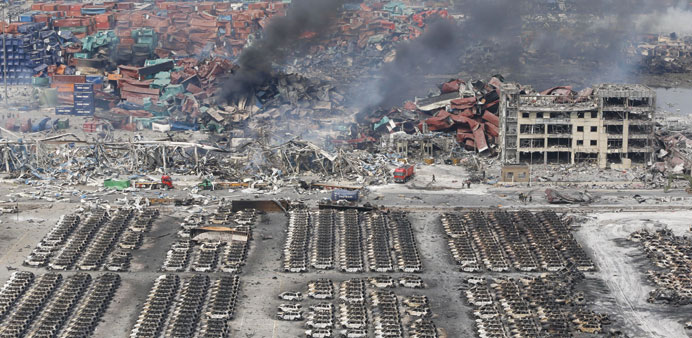Smoke rises yesterday among shipping containers next to damaged vehicles as firefighters try to put out a fire after explosions on Wednesday night, at Binhai new district in Tianjin.
Reuters
Tianjin, China
China has defended firefighters who initially hosed water on a blaze in a warehouse storing volatile chemicals, a response foreign experts said could have contributed to two huge blasts that killed 56 people.
At least 21 fire fighters were among the victims of the explosions at the port in the northeastern city of Tianjin on Wednesday night, the official Xinhua news agency said, calling it possibly the highest death toll among fire crews since the founding of the People’s Republic of China in 1949.
About 720 people were injured, 25 critically with 33 in serious condition, in a nation all too familiar with industrial disasters.
Columns of smoke from fires still burning yesterday rose from the site amid crumpled shipping containers, thousands of torched cars and burnt-out shells of port buildings.
Rescuers pulled one survivor from the wreckage, later identified as a firefighter, a city official told reporters.
The warehouse, designed to house dangerous and toxic chemicals, was storing mainly ammonium nitrate, potassium nitrate and calcium carbide at the time, according to police.
Xinhua has said several containers in the warehouse caught fire before the explosions.
The State Council, China’s cabinet, said a nationwide inspection of dangerous chemicals and explosives would be launched in response to the disaster, along with a crackdown on illegal activities to strengthen industry safety.
“The disastrous explosions at the ... hazardous materials warehouse at Tianjin caused huge loss of life and injuries, economic damages and social impact,” the State Council work safety commission said on its website. “The lessons are extremely profound.”
Chemical safety experts said calcium carbide reacts with water to create acetylene, a highly explosive gas.
An explosion could be caused if fire fighters sprayed the calcium carbide with water, they said.
Lei Jinde, the deputy propaganda department head of China’s fire department, a part of the ministry of public security, told state-backed news website ThePaper.cn that the first group of firefighters on the scene had used water.
“We knew there was calcium carbide inside but we didn’t know whether it had already exploded,” he said.
“At that point no one knew, it wasn’t that the firefighters were stupid,” Lei said, adding that it was a large warehouse and they didn’t know the exact location of the calcium carbide.
CCTV reported that 13 firefighters were still missing. Xinhua said earlier that 66 firefighters were among the hundreds of people hospitalised.
David Leggett, a chemical safety expert based in California, told Reuters that the acetylene explosion could have detonated the ammonium nitrate.
The two blasts were about 30 seconds apart, the second much larger than the first.
“In my mind, the presence of ammonium nitrate makes it easier to explain the level of devastation,” he said.
Stuart Prescott, a senior lecturer in chemical engineering at the University of New South Wales in Australia, said that water was recommended to extinguish the two nitrates but a chemical powder was needed for calcium carbide.
The explosions at the world’s 10th largest port were so big they were seen by satellites in space and registered on earthquake sensors.
Biochemical specialists said on state TV that they were waiting for workers to clear a road into the site so they could begin assessing chemical contamination.
Several thousand residents were moved to 10 schools after apartment buildings and homes were damaged.
Foreign companies were assessing damage to facilities in and around the port, a gateway to northeast China, which accounts for about 40 percent of China’s imported cars, Xinhua reported.
French carmaker Renault said its warehouse at the port sustained severe damage and an early estimate showed nearly 1,500 of its cars there were burned.
Japan’s Toyota Motor Corporation said more than 50 of its employees had been injured.
Mining giant BHP Billiton said its port operations and shipments were disrupted but its iron ore discharging berth had not been damaged.
Oil tanker arrivals and departures were also disrupted. US farm and construction equipment maker John Deere & Co said several workers were injured, some critically.
Swiss logistics firm Panalpina said it was looking into whether exports from China could be funnelled through the ports of Qingdao or Dalian as shipments through Tianjin may be disrupted for a week or longer.
Xinhua identified the owner of the warehouse as Tianjin Dongjiang Port Ruihai International Logistics and the China Daily newspaper said its manager had been detained.
The Tianjin Maritime Safety Administration said in a report in January 2014 that a safety inspection two years ago found several cases where the company had violated packaging standards.
The company said on its website that it was a government-approved firm specialising in handling “dangerous goods”.
Phone numbers listed on the site were disconnected and an e-mail went unanswered.
Industrial accidents are not uncommon in China following three decades of fast growth.
A blast at an auto parts factory killed 75 people a year ago.
The blasts sent shockwaves through apartment blocks kilometres away in the city of 15mn people. They shattered windows in buildings and cars and knocked down walls in a 2km radius.



